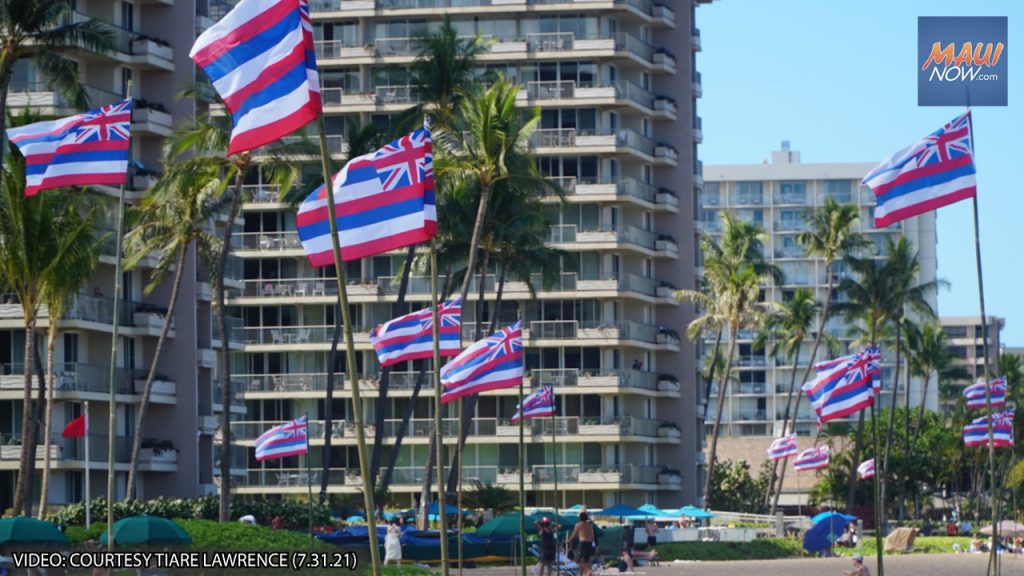Maui resident views on tourism drop, but state perception ticks up — new survey

Nearly half the Maui County residents polled in a recent survey on the visitor industry said the island is being run for tourists at the expense of local people – the highest negative response in the state.
For Maui residents who said tourism creates more problems than benefits, overcrowding was the top concern.
The state’s Spring 2022 Resident Sentiment Survey released Aug. 26 showed 48% of Maui County respondents said they agree with the statement, “This island is being run for tourists at the expense of local people” — up from 39% in the fall of 2021. For Kauaʻi, 39% agreed with the statement, along with 29% for Oʻahu and 26% for Hawaiʻi island.
Overall, the state Department of Business, Economic Development and Tourism said its regular survey showed early signs of strengthening resident sentiment toward tourism. A statewide favorable perception of the tourism industry ticked up from 49% in the fall to 54% this spring.
In 2019, visitors spent nearly $18 billion in Hawaiʻi, which produced $2 billion in state tax revenues to support local schools, hospitals and infrastructure, the survey said.
When asked whether tourism is “worth the issues associated with the industry,” Maui County’s favorability dropped from 73% in the fall to 60% this spring.
A breakdown of areas in Maui County shows that fewer respondents thought the industry was worth the issues. Comparing the fall and spring surveys, those who said tourism is worth it dropped 75% to 58% for West Maui , 72% to 59% for Central / East Maui and 76% to 64% for Moloka’i.
On Lanai, it rose from 83% in the fall to 91% in the spring.
For Maui County residents who said tourism creates more problems than it does benefits, overcrowding is the top concern, followed by damage to the environment and traffic problems, followed by higher prices / cost of living.
Overcrowding on Maui concerns spiked from 62% in fall to 75% this spring.
Using a 10-point scale, where 10 is extremely positive and 1 is extremely negative, 45% of people polled for Maui County ranked the impact of tourism on “you and your family” in the bottom tier: one to five. It showed sentiments have worsened from fall, where 40% answered in the bottom tier.
Kauaʻi followed at 41%, then Oʻahu at 39% and Hawaiʻi island at 37%.
For the spring survey, 63% of those polled in Maui County said it was extremely important that “building of additional hotel/condo/timeshare units” not be allowed. It was an increase from fall, where 53% agreed with the statement.
Maui County Council early this year overrode a veto by Mayor Michael Victorino to implement a temporary moratorium on the construction of new hotel and transient accommodation units. The county is in the process of considering a measure that would make caps on visitor units more permanent. However, opponents to proposed caps said it won’t stop visitors from coming.
Maui County and Kauaʻi this spring both saw an increase in the desire to designate resident-only days of the week at some state parks, beaches and trails. Maui County went from 36% in the fall to 44% in the spring; Kauaʻi went from 39% in the fall to 46% in the spring.
Maui County is in the early stages of public scoping for Park Maui, a program that will charge visitors to park at highly-trafficked county parks and beaches. Touted as a way to manage over-tourism and prioritize residents, the program remains unclear over how it will ensure spots are available for residents. Officials at a recent meeting said parking spots will not be reserved for residents.
Maui County visitors in July reached the highest monthly count since the pandemic, with 304,878 visitors arriving in the islands.
Maui Island Plan, which is part of the Maui County Code, calls for the number of visitors to be no more than one-third of the resident population. Last month, the average daily tourist census shows that there were two residents for each tourist — or about 50% more than the plan.
Since Hawaiʻi reopened to tourism in October 2020, the state has seen a faster resurgence of tourism than it anticipated due to pent-up savings and demand. Although Neighbor Islands rely more on visitor dollars than Oʻahu, Maui County residents in government meetings have asked for better tourism management to mitigate negative impacts to infrastructure, natural resources and resident quality of life.
Resident sentiment toward tourism was fairly strong in the late 1980s up until 2010, then began dropping, according to state data. In 2021, fewer than half of people polled “strongly/somewhat agreed tourism has brought more benefits than problems.”
Resident sentiment, one of the overall Key Performance Indicators of Hawai’i Tourism Authority’s 2020-25 Strategic Plan, has been measured since 1988. The spring survey was conducted by Omnitrak Group Inc. and was fielded from May 7 through July 30. Residents in all four counties participated in the survey by phone and online.
Statewide sampling produced a total of 1955 respondents, including 839 for Oʻahu, 458 for Hawaiʻi island, 403 for Maui County and 255 for Kauaʻi.









